It’s a challenge to introduce unfamiliar flavours to an audience, but we’re excited that someone is finally pushing the boundaries of food tasting sessions in Kolkata. Beyond the usual rice and condiments, the cuisine of Odisha offers a variety of tribal, coastal, and river dishes. To bring these flavours to the city, Gormei and Glenburn Penthouse teamed up to host chef Rachit Kirteeman. The event, called The Odisha Table, took place on August 25. Chef Rachit attempted to make the attendees step outside their comfort zone as he brought fermented rice, pumpkin flowers, red ant chutney, paddy-grown mushrooms and more to the table through his eight-course meal. He even incorporated some local condiments from Lake Market, which he had explored with chef Shaun Kenworthy, ahead of the tasting. A chat with chef Rachit Kirteeman…
My Kolkata: Welcome to Kolkata. How does it feel to be in the city for today’s tasting?
Rachit Kirteeman: For me, this marks the beginning of The Odisha Table. It’s like life has come full circle because I spent my formative years in Kolkata before moving back to Odisha when I was seven. This is the first time such an approach to showcase Odisha food is being taken in India. Traditionally, Odisha’s cuisine had never been thought of in a tasting or grazing menu format, it has always been a thali or a buffet. So, doing something radical with Odia food here in Kolkata and seeing the response has been amazing.
What are some things you kept in mind while tailoring this menu for Kolkata?
One thing I wanted to keep intact was the treatment of ingredients and textures. I wanted to make sure that I retained the textures of the dish but not necessarily using the same ingredients. Odia cuisine doesn’t have courses like Bengali food, where you have the bitter first and then thinner gravies and so on. So, I had to design the tasting experience in such a way that we started championing specific ingredients or techniques in each course.
For instance, the initial course featured Macha Ambila, a thin gravy but we made it into a soup-like starter. This dish hails from a particular community in Cuttack, making it a micro-regional specialty. I didn’t know about it until I tried it at a friend’s wedding.
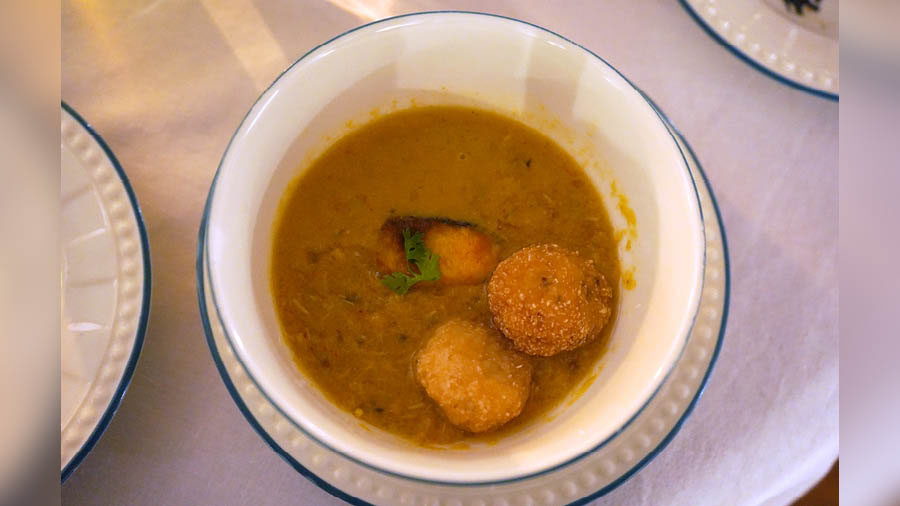
Macha Ambila: The tasting started with Jhola (thin gravy) served in a comfortable bowl. The dish included grilled rohu, wild cucumber curry, urad dal fritters and jeera chilli oil. The dish also had some grains of rice
This exploration led me to celebrate rice, which is so central to Odia culture. But I didn’t want to present it in a generic manner… I want my diners to question me! So, I incorporated rice crackers. I have observed how people in the village preserve excess rice by making rice crackers. Red chilli and jeera powder are also something every Odia household has. You sprinkle it on top of dal, some curry… It’s like magic powder. So, I added that to the rice as well for that flavour.
Coming to the dessert, Rasabali, it is my favourite. Only two or three places used to make it in Odisha but now it is more widespread.
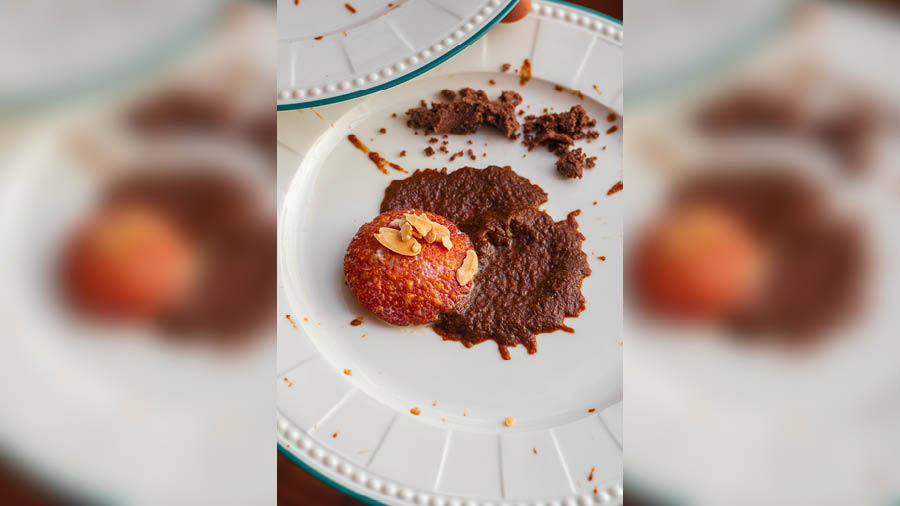
Rasabali: A fried chenna dumpling in reduced milk, accompanied by a side of salted ragi crumble. The dumpling was warm and moist and felt like soft pillows on the chew
Did taking everyone out of their comfort zones pose a risk for you?
It was. I didn’t know how people were going to take it. What if they wanted what they eat when they visit Puri or at wedding feasts? But I’m glad it turned out okay and I got good feedback (laughs).
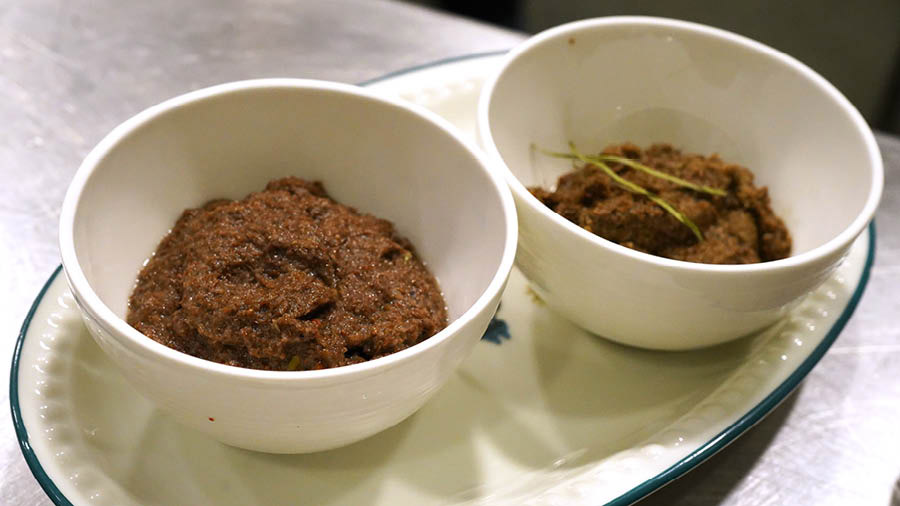
Red ant chutneys: The tasting also came with two unique dips made out of red ants. While one had a spicy kick to it the other had a more ginger-like tang. Both had a musky texture on the tongue
Are you taking any items back with you from Kolkata?
I am taking goyna bori (or gohona bori) for sure… we have a lot of bori but the goyna bori is such a delicate thing and I really love it. I am eating all the good food here where I’m going to all the roll shops, kebab places…
We noticed “hyperlocal produce” in your Instagram bio. What does it mean to you and how do you put it into practice?
Take, for example, the chilli, which was introduced to India by the Portuguese. We never grew them so how did we spice dishes before that? We used Indian long pepper or Pippali, a spice now associated with Ayurveda. You can still find it in Ayurveda shops, but it’s expensive. A little bit of that in a mutton curry or a kheer completely changes the taste. It is spicy and savoury at the same time and has a very nice fennel-meets-cumin taste.
While chilli is widely associated with Indian cuisine, places like Mayurbhanj grow chillies that you will find in Mexico. Such a chilli is Dhani Lanka, which I used in my chutney earlier. It’s a tiny shrub but super spicy. But no one uses that and it’s only found in tribal haats, located 20km away from Baripada town. It is a logistical nightmare to get these hyperlocal ingredients down via the bus and train but it’s worth the effort.
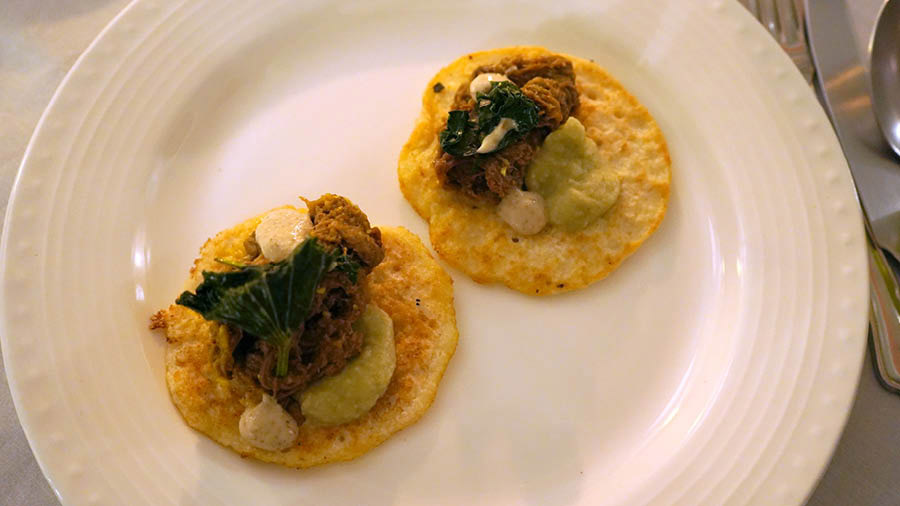
Wedding Feast Style Mutton with Fixings: Slow-cooked mutton, roasted brinjal mash served on rice-lentil pancakes and eaten with a squeeze of lemon. The dish was soft, juicy and tangy, and the topping of ‘muri’ or puffed rice added some crunch
Food is something to which memories are attached. Could you share a specific food item that holds a special memory for you?
One dish deeply embedded in my core memories is the Chicken A La Kiev! When I was a child, my nose would just reach the table in Mocambo. The first time I ordered Chicken A La Kiev, my mother said it was a big portion for a small kid but my curiosity got the best of me. The knife went into it and the butter oozed out! Years later, when I started studying hotel management, I wanted to do a Chicken A La Kiev for a chef competition. Back then, it turned out really bad but over the years I’ve learned to master the dish.
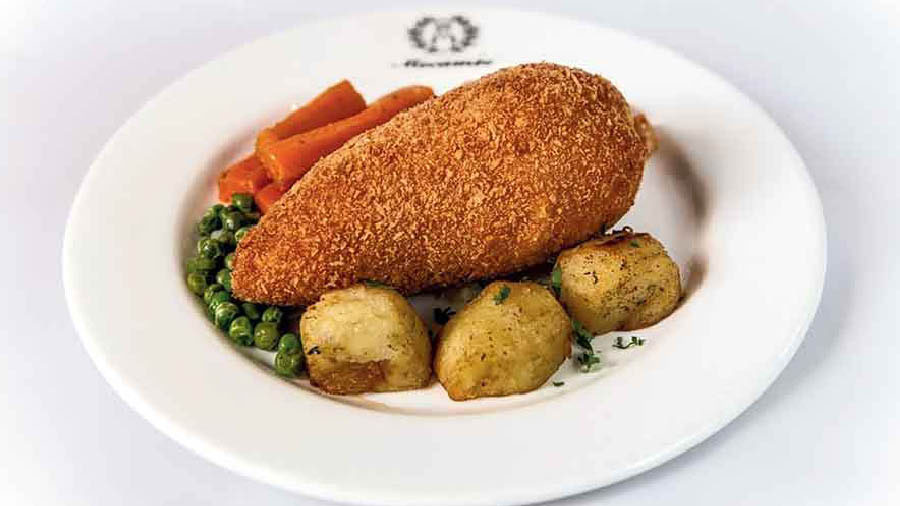
Mocambo’s Chicken A La Kiev TT Archives
In one of your posts where you revisited your Alma mater, you mentioned that Odia food is something that has taken time for people to notice. What makes you say that?
I wouldn’t say it’s overshadowed, but it’s often compared to Bengali cuisine. The Koraput region, for example, is frequently associated with Chhattisgarh, and as you move south in Odisha, people draw parallels to Andhra food. So Odia cuisine never got its due place in the bigger fabric of Indian food. My college, WGSHA Manipal (WelcomGroup Graduate School of Hotel Administration), has a Masters program in Indian cuisine so they bring in chefs from every state to teach, which is great because you expand your horizon.
I’m also doing my part to spread the word about the cuisine by asking people if they want to do podcasts and this and that. In the next two years, I do see the cuisine reaching its fullest potential.
Foodies gather: glimpses from the event featuring happy guests

Argha Sen, founder, Gormei, and (right) Chef Shaun and Pinky Kenworthy

Paul Walsh, former British diplomat and founder of Jungle Crows, and (right) social entrepreneur and folk arts curator Nandita Palchoudhuri


